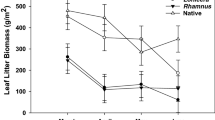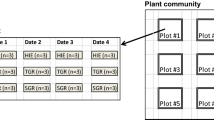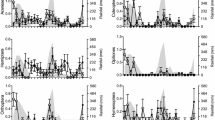Abstract
Decomposition rates of an invasive plant litter in native-species communities can be slower, since decomposers are not adapted to the litter of the invasive species. We have compared rates of plant decomposition and the structure of arthropod communities during the incubation of the litter of the invasive giant goldenrod Solidago gigantea (Asteraceae) and three native species (Urtica dioica, Cirsium arvense, and Chamaenerion angustifolium) in the biotopes with dominance of local and invasive plant species. Our results suggest that the arthropod community involved in decomposition of S. gigantea and other species is not species specific and does not provide a higher or lower rate of decomposition of the invasive species. Neither the rate of litter decomposition, nor the structure and diversity of arthropod communities support the home-field advantage hypothesis.






Similar content being viewed by others
REFERENCES
Gholz, H.L., Wedin, D.A., Smitherman, S.M., et al., Long-term dynamics of pine and hardwood litter in contrasting environments: toward a global model of decomposition, GCB, 2000, vol. 6, no. 7, pp. 751–765.
Ayres, E., Steltzer, H., Simmons, B.L., et al., Home-field advantage accelerates leaf litter decomposition in forests, Soil Biol. Biochem., 2009, vol. 41, no. 3, pp. 606–610.
Veen, G.F., Freschet, G.T., Ordonez, A., and Wardle, D.A., Litter quality and environmental controls of home-field advantage effects on litter decomposition, Oikos, 2015, vol. 124, no. 2, pp. 187–195.
Ehrenfeld, J.G., Effects of exotic plant invasions on soil nutrient cycling processes, Ecosystems, 2003, vol. 6, no. 6, pp. 503–523.
Allison, S.D. and Vitousek, P.M., Rapid nutrient cycling in leaf litter from invasive plants in Hawai’i, Oecologia, 2004, vol. 141, no. 4, pp. 612–619.
Ashton, I.W., Hyatt, L.A., Howe, K.M., et al., Invasive species accelerate decomposition and litter nitrogen loss in a mixed deciduous forest, Ecol. Appl., 2005, vol. 15, no. 4, pp. 1263–1272.
Samye opasnye invazionnye vidy Rossii (TOP-100) (The most Dangerous Invasive Species in Russia (TOP-100)), Dgebuadze, Yu.Yu., Petrosyan, V.G., and Khlyap, L.A., Eds., Moscow: KMK, 2018.
Berg, B. and McClaugherty, C., Plant Litter: Decomposition, Humus Formation, Carbon Sequestration, Berlin: Springer-Verlag, 2008.
R Core Team. R: A language and environment for statistical computing, R Foundation for Statistical Computing, Vienna, 2020.
Perez, G., Aubert, M., Decaëns, T., et al., Home-Field Advantage: A matter of interaction between litter biochemistry and decomposer biota, Soil Biol. Biochem., 2013, vol. 67, pp. 245–254.
Ayres, E., Steltzer, H., Berg, S., and Wall, D.H., Soil biota accelerate decomposition in high-elevation forests by specializing in the breakdown of litter produced by the plant species above them, J. Ecol., 2009, vol. 97, no. 5, pp. 901–912.
Canty, A. and Ripley, B., Boot: Bootstrap R (S-Plus) functions (R package version 1.3-9), R Foundation for Statistical Computing, Vienna, 2013.
Oksanen, J., Kindt, R., Legendre, P., et al., The vegan package, Community Ecology Package, 2007, vol. 10, pp. 631–637.
McTee, M.R., Lekberg, Y., Mummey, D., et al., Do invasive plants structure microbial communities to accelerate decomposition in intermountain grasslands?, Ecol. Evol., 2017, vol. 7, no. 24, pp. 11227–11235.
Gießelmann, U.C., Martins, K.G., Brändle, M., et al., Lack of home-field advantage in the decomposition of leaf litter in the Atlantic Rainforest of Brazil, Appl. Soil Ecol., 2011, vol. 49, pp. 5–10.
John, M.G.S., Orwin, K.H., and Dickie, I.A., No ‘home’ versus ‘away’ effects of decomposition found in a grassland–forest reciprocal litter transplant study, Soil Biol. Biochem., 2011, vol. 43, no. 7, pp. 1482–1489.
Gartner, T.B. and Cardon, Z.G., Decomposition dynamics in mixed-species leaf litter, Oikos, 2004, vol. 104, no. 2, pp. 230–246.
Hättenschwiler, S., Tiunov, A.V., and Scheu, S., Biodiversity and litter decomposition in terrestrial ecosystems, Annu. Rev. Ecol. Evol. Syst., 2005, vol. 36, pp. 191–218.
Shilenkova, O.L. and Tiunov, A.V., Soil-litter nitrogen transfer and changes in δ13C and δ15N values in decomposing leaf litter during laboratory incubation, Pedobiologia, 2013, vol. 56, no. 3, pp. 147–152.
Gergócs, V., Rétháti, G., and Hufnagel, L., Litter quality indirectly influences community composition, reproductive mode and trophic structure of oribatid mite communities: a microcosm experiment, Exp. Appl. Acarol., 2015, vol. 67, no. 3, pp. 335–356.
Stefanowicz, A.M., Stanek, M., Nobis, M., and Zubek, S., Species-specific effects of plant invasions on activity, biomass, and composition of soil microbial communities, Biol. Fertil. Soils, 2016, vol. 52, no. 6, pp. 841–852.
Wang, C., Jiang, K., Zhou, J., and Wu, B., Solidago canadensis invasion affects soil N-fixing bacterial communities in heterogeneous landscapes in urban ecosystems in East China, Sci. Total Environ., 2018, vol. 631, pp. 702–713.
Zhang, C.B., Wang, J., Qian, B.Y., and Li, W.H., Effects of the invader Solidago canadensis on soil properties, Appl. Soil Ecol., 2009, vol. 43, nos. 2–3, pp. 163–169.
Scharfy, D., Güsewell, S., Gessner, M.O., and Venterink, H.O., Invasion of Solidago gigantea in contrasting experimental plant communities: effects on soil microbes, nutrients and plant-soil feedbacks, J. Ecol., 2010, vol. 98, no. 6, pp. 1379–1388.
Sterzyńska, M., Shrubovych, J., and Nicia, P., Impact of plant invasion (Solidago gigantea L.) on soil mesofauna in a riparian wet meadows, Pedobiologia, 2017, vol. 64, pp. 1–7.
Ustinova, E.N., Schepetov, D.M., Lysenkov, S.N., and Tiunov, A.V., Soil arthropod communities are not affected by invasive Solidago gigantea Aiton (Asteraceae), based on morphology and metabarcoding analyses, Soil Biol. Biochem., 2021, vol. 159, art. ID 108288.
ACKNOWLEDGMENTS
We thank the experts who carried out taxonomic identification of soil arthropods: Collembola—A.Yu. Korotkevich (Moscow State Pedagogical University, Zoology and Ecology Department); Oribatida—V.D. Leonov (Institute of Ecology and Evolution, Russian Academy of Sciences); Mesostigmata—M.S. Bizin (Institute of Ecology and Evolution, Russian Academy of Sciences).
Author information
Authors and Affiliations
Corresponding author
Additional information
Translated by T. Kuznetsova
Rights and permissions
About this article
Cite this article
Ustinova, E.N., Maslov, M.N., Lysenkov, S.N. et al. Decomposition Rates and Community Structure of Arthropods in the Litter of Invasive Solidago gigantea Do Not Support the Home-Field Advantage Hypothesis. Russ J Ecol 53, 328–334 (2022). https://doi.org/10.1134/S1067413622040063
Received:
Revised:
Accepted:
Published:
Issue Date:
DOI: https://doi.org/10.1134/S1067413622040063




